RS Aggarwal Class 9 Chapter Lines & Angles Exercise 4D Solution
EXERCISE 4D
Question 1:
Since, sum of the angles of a triangle is 180o
∠A + ∠B + ∠C = 180o
⇒ ∠A + 76o + 48o = 180o
⇒ ∠A = 180o – 124o = 56o
∴ ∠A = 56o
Question 2:
Let the measures of the angles of a triangle are (2x)o, (3x)o
and (4x)o.
Then, 2x + 3x + 4x = 180 [sum of the angles of a triangle is 180o ]
⇒ 9x = 180
⇒ x = \(\frac { 180 }{ 9 } \) = 20
∴ The measures of the required angles are:
2x = (2 × 20)o = 40o
3x = (3 × 20)o = 60o
4x = (4 × 20)o = 80o
Question 3:
Let 3∠A = 4∠B = 6∠C = x (say)
Then, 3∠A = x
⇒ ∠A = \(\frac { x }{ 3 } \)
4∠B = x
⇒ ∠B = \(\frac { x }{ 4 } \)
and 6∠C = x
⇒ ∠C = \(\frac { x }{ 6 } \)
As ∠A + ∠B + ∠C = 180o
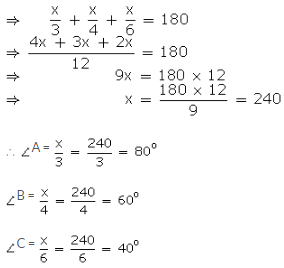
Question 4:
∠A + ∠B = 108o [Given]
But as ∠A, ∠B and ∠C are the angles of a triangle,
∠A + ∠B + ∠C = 180o
⇒ 108o + ∠C = 180o
⇒ C = 180o – 108o = 72o
Also, ∠B + ∠C = 130o [Given]
⇒ ∠B + 72o = 130o
⇒ ∠B = 130o – 72o = 58o
Now as, ∠A + ∠B = 108o
⇒ ∠A + 58o = 108o
⇒ ∠A = 108o – 58o = 50o
∴ ∠A = 50o, ∠B = 58o and ∠C = 72o.
Question 5:
Since. ∠A , ∠B and ∠C are the angles of a triangle .
So, ∠A + ∠B + ∠C = 180o
Now, ∠A + ∠B = 125o [Given]
∴ 125o + ∠C = 180o
⇒ ∠C = 180o – 125o = 55o
Also, ∠A + ∠C = 113o [Given]
⇒ ∠A + 55o = 113o
⇒ ∠A = 113o – 55o = 58o
Now as ∠A + ∠B = 125o
⇒ 58o + ∠B = 125o
⇒ ∠B = 125o – 58o = 67o
∴ ∠A = 58o, ∠B = 67o and ∠C = 55o.
Question 6:
Since, ∠P, ∠Q and ∠R are the angles of a triangle.
So, ∠P + ∠Q + ∠R = 180o ….(i)
Now, ∠P – ∠Q = 42o [Given]
⇒ ∠P = 42o + ∠Q ….(ii)
and ∠Q – ∠R = 21o [Given]
⇒ ∠R = ∠Q – 21o ….(iii)
Substituting the value of ∠P and ∠R from (ii) and (iii) in (i), we get,
⇒ 42o + ∠Q + ∠Q + ∠Q – 21o = 180o
⇒ 3∠Q + 21o = 180o
⇒ 3∠Q = 180o – 21o = 159o
∠Q = \(\frac { 159 }{ 3 } \) = 53o
∴ ∠P = 42o + ∠Q
= 42o + 53o = 95o
∠R = ∠Q – 21o
= 53o – 21o = 32o
∴ ∠P = 95o, ∠Q = 53o and ∠R = 32o.
Question 7:
Given that the sum of the angles A and B of a ABC is 116o, i.e., ∠A + ∠B
= 116o.
Since, ∠A + ∠B + ∠C = 180o
So, 116o + ∠C = 180o
⇒ ∠C = 180o – 116o = 64o
Also, it is given that:
∠A – ∠B = 24o
⇒ ∠A = 24o + ∠B
Putting, ∠A = 24o + ∠B in ∠A + ∠B = 116o, we get,
⇒ 24o + ∠B + ∠B = 116o
⇒ 2∠B + 24o = 116o
⇒ 2∠B = 116o – 24o = 92o
∠B = \(\frac { 92 }{ 2 } \) = 46o
Therefore, ∠A = 24o + 46o = 70o
∴ ∠A = 70o, ∠B = 46o and ∠C = 64o.
Question 8:
Let the two equal angles, A and B, of the triangle be xo each.
We know,
∠A + ∠B + ∠C = 180o
⇒ xo + xo + ∠C = 180o
⇒ 2xo + ∠C = 180o ….(i)
Also, it is given that,
∠C = xo + 18o ….(ii)
Substituting ∠C from (ii) in (i), we get,
⇒ 2xo + xo + 18o = 180o
⇒ 3xo = 180o – 18o = 162o
x = \(\frac { 162 }{ 3 } \) = 54o
Thus, the required angles of the triangle are 54o, 54o and
xo + 18o = 54o + 18o = 72o.
Question 9:
Let ∠C be the smallest angle of ABC.
Then, ∠A = 2∠C and B = 3∠C
Also, ∠A + ∠B + ∠C = 180o
⇒ 2∠C + 3∠C + ∠C = 180o
⇒ 6∠C = 180o
⇒ ∠C = 30o
So, ∠A = 2∠C = 2 (30o) = 60o
∠B = 3∠C = 3 (30o) = 90o
∴ The required angles of the triangle are 60o, 90o,
30o.
Question 10:
Let ABC be a right angled triangle and ∠C = 90o
Since, ∠A + ∠B + ∠C = 180o
⇒ ∠A + ∠B = 180o – ∠C = 180o – 90o =
90o
Suppose ∠A = 53o
Then, 53o + ∠B = 90o
⇒ ∠B = 90o – 53o = 37o
∴ The required angles are 53o, 37o and 90o.
Question 11:
Let ABC be a triangle.
Given, ∠A + ∠B = ∠C
We know, ∠A + ∠B + ∠C = 180o
⇒ ∠C + ∠C = 180o
⇒ 2∠C = 180o
⇒ ∠C = \(\frac { 180 }{ 2 } \) = 90o
So, we find that ABC is a right triangle, right angled at C.
Question 12:
Given : ∆ABC in which ∠A = 90o, AL ⊥ BC
To Prove: ∠BAL = ∠ACB
Proof :
In right triangle ∆ABC,
⇒ ∠ABC + ∠BAC + ∠ACB = 180o
⇒ ∠ABC + 90o + ∠ACB = 180o
⇒ ∠ABC + ∠ACB = 180o – 90o
∴ ∠ABC + ∠ACB = 90o
⇒ ∠ ACB = 90o – ∠ABC ….(1)
Similarly since ∆ABL is a right triangle, we find that,
∠BAL = 90o – ∠ABC …(2)
Thus from (1) and (2), we have
∴ ∠BAL = ∠ACB (Proved)
Question 13:
Let ABC be a triangle.
So, ∠A < ∠B + ∠C
Adding A to both sides of the inequality,
⇒ 2∠A < ∠A + ∠B + ∠C
⇒ 2∠A < 180o [Since ∠A + ∠B + ∠C = 180o]
⇒ ∠A < \(\frac { 180 }{ 2 } \) = 90o
Similarly, ∠B < ∠A + ∠C
⇒ ∠B < 90o
and ∠C < ∠A + ∠B
⇒ ∠C < 90o
∆ABC is an acute angled triangle.
Question 14:
Let ABC be a triangle and ∠B > ∠A + ∠C
Since, ∠A + ∠B + ∠C = 180o
⇒ ∠A + ∠C = 180o – ∠B
Therefore, we get
∠B > 180o – ∠B
Adding ∠B on both sides of the inequality, we get,
⇒ ∠B + ∠B > 180o – ∠B + ∠B
⇒ 2∠B > 180o
⇒ ∠B > \(\frac { 180 }{ 2 } \) = 90o
i.e., ∠B > 90o which means ∠B is an obtuse angle.
∆ABC is an obtuse angled triangle.
Question 15:
Since ∠ACB and ∠ACD form a linear pair.
So, ∠ACB + ∠ACD = 180o
⇒ ∠ACB + 128o = 180o
⇒ ∠ACB = 180o – 128 = 52o
Also, ∠ABC + ∠ACB + ∠BAC = 180o
⇒ 43o + 52o + ∠BAC = 180o
⇒ 95o + ∠BAC = 180o
⇒ ∠BAC = 180o – 95o = 85o
∴ ∠ACB = 52o and ∠BAC = 85o.
Question 16:
As ∠DBA and ∠ABC form a linear pair.
So, ∠DBA + ∠ABC = 180o
⇒ 106o + ∠ABC = 180o
⇒ ∠ABC = 180o – 106o = 74o
Also, ∠ACB and ∠ACE form a linear pair.
So, ∠ACB + ∠ACE = 180o
⇒ ∠ACB + 118o = 180o
⇒ ∠ACB = 180o – 118o = 62o
In ∠ABC, we have,
∠ABC + ∠ACB + ∠BAC = 180o
74o + 62o + ∠BAC = 180o
⇒ 136o + ∠BAC = 180o
⇒ ∠BAC = 180o – 136o = 44o
∴ In triangle ABC, ∠A = 44o, ∠B = 74o and ∠C = 62o
Question 17:
(i) ∠EAB + ∠BAC = 180o [Linear pair angles]

110o + ∠BAC = 180o
⇒ ∠BAC = 180o – 110o = 70o
Again, ∠BCA + ∠ACD = 180o [Linear pair angles]
⇒ ∠BCA + 120o = 180o
⇒ ∠BCA = 180o – 120o = 60o
Now, in ∆ABC,
∠ABC + ∠BAC + ∠ACB = 180o
xo + 70o + 60o = 180o
⇒ x + 130o = 180o
⇒ x = 180o – 130o = 50o
∴ x = 50
(ii)

In ∆ABC,
∠A + ∠B + ∠C = 180o
⇒ 30o + 40o + ∠C = 180o
⇒ 70o + ∠C = 180o
⇒ ∠C = 180o – 70o = 110o
Now ∠BCA + ∠ACD = 180o [Linear pair]
⇒ 110o + ∠ACD = 180o
⇒ ∠ACD = 180o – 110o = 70o
In ∆ECD,
⇒ ∠ECD + ∠CDE + ∠CED = 180o
⇒ 70o + 50o + ∠CED = 180o
⇒ 120o + ∠CED = 180o
∠CED = 180o – 120o = 60o
Since ∠AED and ∠CED from a linear pair
So, ∠AED + ∠CED = 180o
⇒ xo + 60o = 180o
⇒ xo = 180o – 60o = 120o
∴ x = 120
(iii)
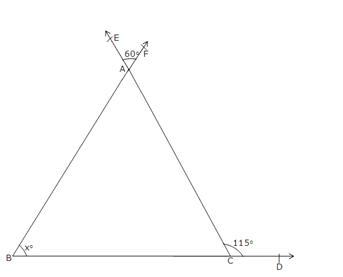
∠EAF = ∠BAC [Vertically opposite angles]
⇒ ∠BAC = 60o
In ∆ABC, exterior ∠ACD is equal to the sum of two opposite interior angles.
So, ∠ACD = ∠BAC + ∠ABC
⇒ 115o = 60o + xo
⇒ xo = 115o – 60o = 55o
∴ x = 55
(iv)
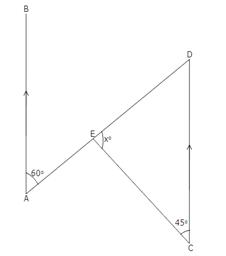
Since AB || CD and AD is a transversal.
So, ∠BAD = ∠ADC
⇒ ∠ADC = 60o
In ∠ECD, we have,
∠E + ∠C + ∠D = 180o
⇒ xo + 45o + 60o = 180o
⇒ xo + 105o = 180o
⇒ xo = 180o – 105o = 75o
∴ x = 75
(v)

In ∆AEF,
Exterior ∠BED = ∠EAF + ∠EFA
⇒ 100o = 40o + ∠EFA
⇒ ∠EFA = 100o – 40o = 60o
Also, ∠CFD = ∠EFA [Vertically Opposite angles]
⇒ ∠CFD = 60o
Now in ∆FCD,
Exterior ∠BCF = ∠CFD + ∠CDF
⇒ 90o = 60o + xo
⇒ xo = 90o – 60o = 30o
∴ x = 30
(vi)
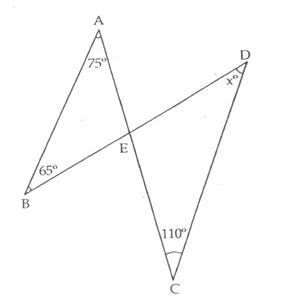
In ∆ABE, we have,
∠A + ∠B + ∠E = 180o
⇒ 75o + 65o + ∠E = 180o
⇒ 140o + ∠E = 180o
⇒ ∠E = 180o – 140o = 40o
Now, ∠CED = ∠AEB [Vertically opposite angles]
⇒ ∠CED = 40o
Now, in ∆CED, we have,
∠C + ∠E + ∠D = 180o
⇒ 110o + 40o + xo = 180o
⇒ 150o + xo = 180o
⇒ xo = 180o – 150o = 30o
∴ x = 30
Question 18:
Produce CD to cut AB at E.
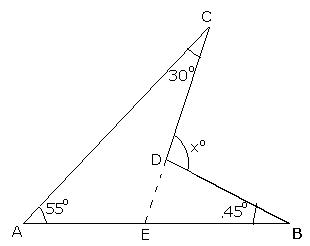
Now, in ∆BDE, we have,
Exterior ∠CDB = ∠CEB + ∠DBE
⇒ xo = ∠CEB + 45o …..(i)
In ∆AEC, we have,
Exterior ∠CEB = ∠CAB + ∠ACE
= 55o + 30o = 85o
Putting ∠CEB = 85o in (i), we get,
xo = 85o + 45o = 130o
∴ x = 130
Question 19:
The angle ∠BAC is divided by AD in the ratio 1 : 3.
Let ∠BAD and ∠DAC be y and 3y, respectively.
As BAE is a straight line,
∠BAC + ∠CAE = 180o [linear pair]
⇒ ∠BAD + ∠DAC + ∠CAE = 180o
⇒ y + 3y + 108o = 180o
⇒ 4y = 180o – 108o = 72o
⇒ y = \(\frac { 72 }{ 4 } \) = 18o
Now, in ∆ABC,
∠ABC + ∠BCA + ∠BAC = 180o
y + x + 4y = 180o
[Since, ∠ABC = ∠BAD (given AD = DB) and ∠BAC = y + 3y = 4y]
⇒ 5y + x = 180
⇒ 5 × 18 + x = 180
⇒ 90 + x = 180
∴ x = 180 – 90 = 90
Question 20:
Given : A ∆ABC in which BC, CA and AB are produced to D, E and F respectively.
To prove : Exterior ∠DCA + Exterior ∠BAE + Exterior ∠FBD = 360o
Proof : Exterior ∠DCA = ∠A + ∠B ….(i)
Exterior ∠FAE = ∠B + ∠C ….(ii)
Exterior ∠FBD = ∠A + ∠C ….(iii)
Adding (i), (ii) and (iii), we get,
Ext. ∠DCA + Ext. ∠FAE + Ext. ∠FBD
= ∠A + ∠B + ∠B + ∠C + ∠A + ∠C
= 2∠A + 2∠B + 2∠C
= 2 (∠A + ∠B + ∠C)
= 2 × 180o
[Since, in triangle the sum of all three angle is 180o]
= 360o
Hence, proved.
Question 21:
In ∆ACE, we have,
∠A + ∠C + ∠E = 180o ….(i)
In ∆BDF, we have,
∠B + ∠D + ∠F = 180o ….(ii)
Adding both sides of (i) and (ii), we get,
∠A + ∠C +∠E + ∠B + ∠D + ∠F = 180o + 180o
⇒ ∠A + ∠B + ∠C + ∠D + ∠E + ∠F = 360o.
Question 22:
Given : In ∆ABC, bisectors of ∠B and ∠C meet at O and ∠A = 70o
In ∆BOC, we have,
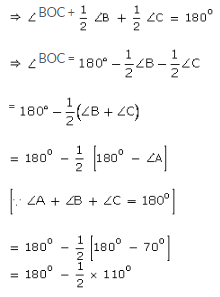
∠BOC + ∠OBC + ∠OCB = 180o
= 180o – 55o = 125o
∴ ∠BOC = 125o.
Question 23:
We have a ∆ABC whose sides AB and AC have been procued to D and E. A =
40o and bisectors of ∠CBD and ∠BCE meet at O.
In ∆ABC, we have,
Exterior ∠CBD = C + 40o

And exterior ∠BCE = B + 40o

Now, in ∆BCO, we have,
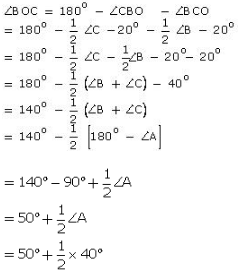
= 50o + 20o
= 70o
Thus, ∠BOC = 70o
Question 24:
In the given ∆ABC, we have,
∠A : ∠B : ∠C = 3 : 2 : 1
Let ∠A = 3x, ∠B = 2x, ∠C = x. Then,
∠A + ∠B + ∠C = 180o
⇒ 3x + 2x + x = 180o
⇒ 6x = 180o
⇒ x = 30o
∠A = 3x = 3 30o = 90o
∠B = 2x = 2 30o = 60o
and, ∠C = x = 30o
Now, in ∆ABC, we have,
Ext ∠ACE = ∠A + ∠B = 90o + 60o = 150o
∠ACD + ∠ECD = 150o
⇒ ∠ECD = 150o – ∠ACD
⇒ ∠ECD = 150o – 90o [since , AD ⊥ CD, ∠ACD =
90o]
⇒ ∠ECD= 60o
Question 25:
In ∆ABC, AN is the bisector of ∠A and AM ⊥ BC.
Now in ∆ABC we have;
∠A = 180o – ∠B – ∠C
⇒ ∠A = 180o – 65o – 30o
= 180o – 95o
= 85o
Now, in ∆ANC we have;

Thus, ∠MAN =
Question 26:
(i) False (ii) True (iii) False (iv) False (v) True (vi) True.